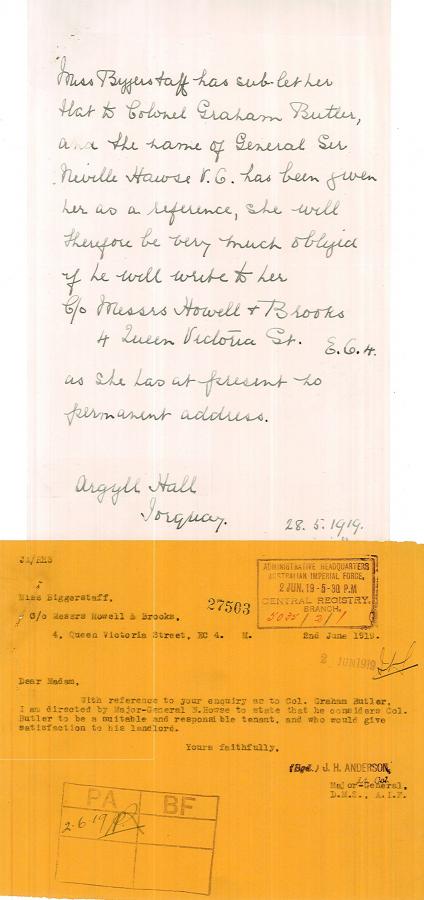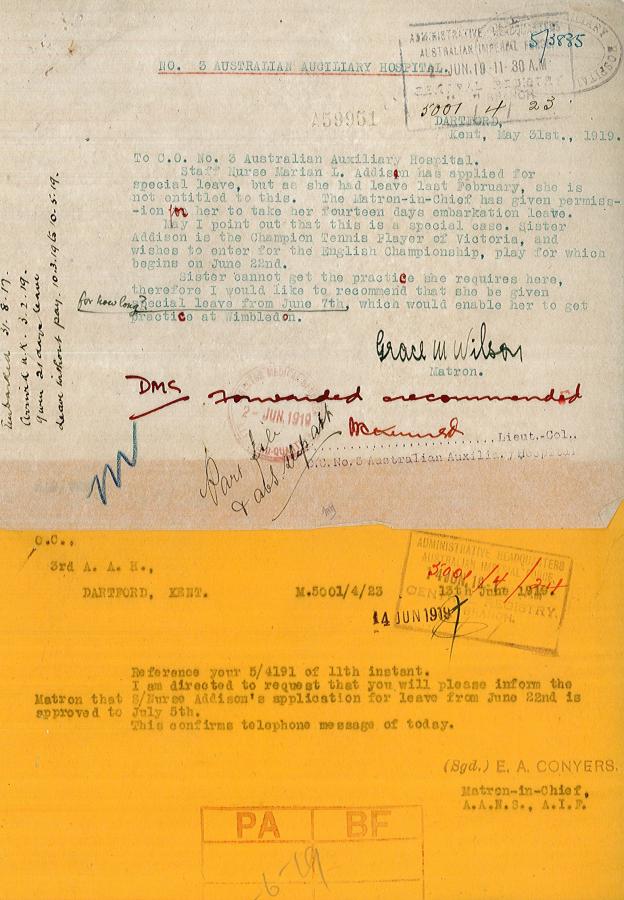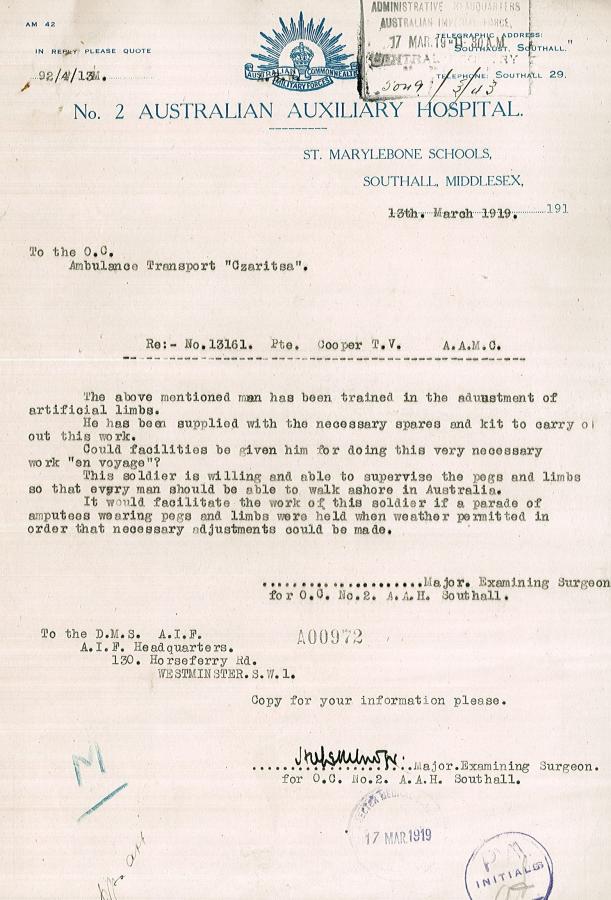Highlight on official records of the First World War: AWM12, Australian Imperial Force Headquarters (London), Administrative registry medical/personal files, 1914-18 War
Highlight on the official records of the First World War is a centenary program of posts highlighting those records created 100 years ago, why they exist and how we can help make these essential records available for research purposes.
Function and provenance
This registry was set up in London as part of Australian Imperial Force (AIF) Headquarters to handle all incoming inter-departmental and external correspondence that related to individual members attached to medical units.
In 1915, a small Australian military headquarters had been set up in London by the Australian High Commissioner. The role of the headquarters was to finance and provision the AIF and to keep records of the location and condition of convalescents coming in ever increasing numbers from the Dardanelles (by November 1915, 10,000 troops).
The Horseferry Road offices (formerly the Westminster Methodist Training College) were located by Captain H. C. Smart and leased by the Australian High Commissioner in October 1915. Smart “organised a records office, employing a few military supervisors with a large number of girls, whose labour was as effective as that of the soldiers, and much cheaper”.
The records were returned to Australia following the war and retained by Dept of Defence until completion of the writing of the medical history in 1943, after which they were transferred to the Australian War Memorial. The records in this registry were assessed as being of interest to the Medical Historian (Colonel A. G. Butler), as they supplied particulars of the posting of medical officers and nurses; of Australian nurses serving in the British forces, and of civilians rendering social services to the AIF.
Treloar wrote in support of the records coming to the Memorial “There can be little doubt that the value of these records will increase with time. The administrative side of the AIF is probably well known to those now engaged in writing history, but to the historians and students of the future these records must form the basis of any reliable work.”
Content
The contents of the files relate to administrative matters, eg.
- Application for passage to Australia
- Medical permission to land in Australia
- Medical board’s reports results advised
- Voyage conducting officers
- Pay and allowances
- Remission of forfeiture of pay
- Appointment of medical officers to ships returning to Australia
- Disposal of dental stores
- Unit transfers
- Discharge from the service
- Civil employment
- Repatriation and demobilisation
- Pensions
- Leave with/without pay
- Discharge for family reasons
- Embarkation.
- The files may typically contain:
- Requests for individuals to be released from duties for further employment;
- Notifications of approvals for leave applications
- Queries as to processing of Non Military Employment (NME) leave applications
- Supporting medical certificates for requests for assisted passage to Australia from family members of personnel
- Requests for evidence of personnel being on duty at Horseferry Road
- Notification of transfers
- Notifications of location of personnel
- AIF Form no. 537 Australian Imperial Force Department of Repatriation and Demobilisation Application for Early Repatriation.
- Officers and servicemen requesting leave to stay in England for special training
- Officers and servicemen requesting special consideration as to quicker return to Australia – usually financial hardship or bereavements in the family
- Information on psychiatric cases and the special arrangements for their care on board their return ship
- Correspondence relating to the whereabouts of certain hospital and psychiatric cases
- Information relating to the marriage and or return of nursing staff who were employed on the return journey to Australia
- Requests for consideration of payment for surgical equipment (artificial eyes and limbs) that were supplied in England to servicemen returning home.
There is much human interest and family information in the files that remain. Nurses and men with family commitments in Australia wrote to be repatriated early and to add weight to their cases by providing evidence of extenuating family circumstances in their AIF Forms no. 537 Department of Repatriation and Demobilisation, Application for Early Repatriation.
For men still in England with ongoing medical conditions, the treatment of them by British civilian doctors is recorded in the files as they sought payment for services rendered or for moneys they themselves outlaid to be reimbursed. There are poignant cases where the orthopaedic devices supplied initially to wounded men were found to be unsatisfactory. Despite their repeated requests, some men were not supplied with more satisfactory replacements. There are also cases of men requesting reinstatement of full pay without penalty, due to clerical or diagnostic errors in their regular checks for sexually transmitted diseases.
There is also much information that relates to nurses and the administrative processes for assigning medical staff to the ships returning to Australia, sometimes with details of the ship on which they returned. We find from the records that Colonel Graham Butler (WW1 Medical Historian) was a good tenant (5035/2/1) and that Staff Nurse Marian L. Addison requested leave to compete in the English Tennis Championships, 1919. There are other records that enrich the background of our knowledge about the return of troops after wounding, like the offer from Cooper (5049/3/43) for his services on board a ship returning to Australia to adjust the pegs of limbs for soldiers fitted with those devices, so that “everyman could walk ashore in Australia”.
The records are rich with personal stories, family information, administrative history and clerical pragmatism.



System of arrangement and control
The files (either one or two folios with some notes and copies of correspondence) are arranged alphabetically, based on the Roneo office system devised to “clump” the alphabetic sequence into the most commonly known groups.
There are two types of files. The first (Folder No. 1616) is titled “Register and movements of papers belonging to this file” Printed headings for this file allows for “Subject – Date – Particulars – Submitted to – Date Returned”. The record file (Folder No. 1618) differs from the first in its layout (its title is the same as the first). The layout consists of twelve blocks, ten of which is for the “subject” with sub headings” Date – Our No. – Their No. – Submitted to – Date returned (relating to correspondence). Each block allows for 9 entries.
The remaining two blocks allow for cross-referencing to other files.
Using the series
The file covers (some were printed with AIF Correspondence Registration Folder), were used to hold miscellaneous personal correspondence, notes, completed forms which were awaiting registration and processing by the registry. After registration, the contents of the file covers were sent to the appropriate agency for action and for filing in other series.
Part of the process of registration included the preparation of a gummed slip that summarised the contents of the correspondence; the sender and the addressee and the subject of the correspondence. These slips were typed as part of the registration process and some files in the series consist only of these pasted slips. Usually the incoming correspondence was placed in the correct alphabetical category for the surname group folder at the beginning of the sequence. Large amounts of correspondence for an individual resulted in file being created individually. Not every person listed on the group file has an individual file.
As with any archival records, there can be inconsistencies or errors in the spelling of names. Researchers not finding an individual’s correct spelling may need to consider searching under alternate or slightly different spellings.
Some files contain completed AIF Form no. 537 Australian Imperial Force Department of Repatriation and Demobilisation Application for Early Repatriation. Some of these also include correspondence to high-level military leaders from appellants themselves or from others on behalf of appellants for early repatriation to Australia. The decision-making process as to which services staff (male or female), particularly nurses, were allocated to ships leaving can be seen in the files. The primary criterion for repatriation earlier than the allocated slot was length of service and extenuating circumstances relating to business (doctor’s practices) and health of parents and family breadwinners.
Much of the correspondence is between the AIF Headquarters and Depots and Hospitals querying the location and status of servicemen and servicewomen. For administrative purposes, the Depots operated independently of AIF Headquarters.
AWM12 is not presently digitised for access on the Australian War Memorial’s website. Researchers may use the National Archives of Australia online database, RecordSearch to examine the items in this series. Items may be retrieved and viewed in the Memorial’s Reading Room.
The Research Centre Reading Room is open Monday to Friday from 10 am to 4.50 pm and on Saturdays from 1pm to 4.50 pm. It is closed on Sundays and ACT public holidays.
The Research Centre telephone service is available from 9am until 5pm Monday to Friday excluding ACT public holidays. Call the Research Centre on (02) 6243 4315.
Sources
AWM12 series dossier
AWM12, 5035/2/1 [Australian Imperial Force Headquarters (London) Administrative Registry - Medical personnel administration files]: Lieutenant Colonel A G Butler [Individual file]
AWM12, 5001/4 Part 3 [Australian Imperial Force Headquarters (London) Administrative Registry - Medical personnel administration files]. AD Miscellaneous [Group file] - [/21] 2934 W G Addison; [/22] 2612 Private S V Adamson; [/23] Staff Nurse M L Adison [or Addison]; [/24] Lieutenant Adamson; [/25] 5785 Private G L Adney; [/26] 8838 Private C R Adamson; [/27] Edith and Elsie Adamson; [/28] 131 Private T N Adams; [/29] Adastral Limited [struck through]; [/30] [Continuation of ] 8838 Private C R Adamson
AWM12, 5049/3/43 [Australian Imperial Force Headquarters (London) Administrative Registry - Medical personnel administration files]: 13161 T B Cooper [Individual file]
AWM93, 12/5/208/6 [Australian War Memorial registry file:] Records of government departments - Defence Department records - Departmental and military including Base Records.